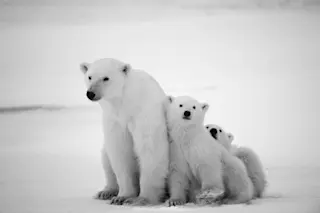December is here and so is chilly weather. That is, if you live in a place where it does get chilly. For these 10 animals, where they live, it's always cold. They are known as chionophiles, or organisms that love and thrive in the snow.
These cold-weather animals have evolved to stay warm and well-fed even in the most frigid conditions. Find out how below!
1. Polar Bear

Credit: (Sergey Uryadnikov/Shutterstock)
(Sergey Uryadnikov/Shutterstock
One of the most popular cold-weather animals is the polar bear. They are the largest bears in the world and are symbols of strength and perseverance in the wild. Polar bears have black skin and transparent fur. Their tongues are also blue! Their fur coats are oily to help keep excess water from penetrating the fur and making them cold.
Where Do Polar Bears Live?
These white bears are at the top of the food chain in the Arctic circle. They are found across various countries that border the Arctic Ocean, including Norway (specifically the Svalbard archipelago), Russia, the United States (Alaska), Canada, and Greenland. They spend much of their lives in the water hunting for food.
What Do Polar Bears Eat?
Polar bears primarily feed on seals, which are their main source of food. They are especially adept at hunting ringed and bearded seals, which they catch using the sea ice as a platform. Polar bears rely on the ice to ambush seals at breathing holes or haul-out sites. In addition to seals, they occasionally consume other food items, including walruses, beluga whales, bird eggs, and carrion. Polar bears also rely heavily on ice sheets for travel, rest, and mating.
Are Polar Bears Endangered?
Due to climate change, however, there is less and less ice and the population of polar bears is decreasing. The global polar bear population is estimated to be around 20,000. The International Union for Conservation of Nature (IUCN) classifies them as vulnerable.
Read More: 5 Things You Never Knew About Polar Bears
2. Snow Leopard

Credit:(Vladimir Turkenich/Shutterstock)
Snow leopards’ gray-white pebbled fur helps them camouflage perfectly into the landscape. They blend in so well; they have been referred to as "ghosts of the mountain." They also have strong back legs that can propel them six times their length and a long tail for balance and warmth.
Where Do Snow Leopards Live?
Snow Leopards are found in the high, rugged mountain ranges of Central Asia: Afghanistan, Bhutan, China, India, Kazakhstan, Kyrgyz Republic, Mongolia, Nepal, Pakistan, Russia, Tajikistan, and Uzbekistan. They are well adapted to living in cold, mountainous environments.
What Do Snow Leopards Eat?
They are carnivores, preying on mountain ibex, blue sheep, Tibetan sheep, and other mountain ungulates. They are also known to hunt smaller animals like hares and birds. Snow Leopards are ambush predators, adept at navigating their difficult terrain.
Are Snow Leopards Endangered?
While these cold-weather animals are incredibly beautiful, their species is threatened. Climate change, habitat loss, food scarcity, and poaching are major threats to the snow leopards' way of life. The global population of snow leopards is estimated to number less than 10,000 mature individuals and is expected to decline about 10 percent by 2040.
Read More: Are Snow Leopards Endangered?
3. Emperor Penguins
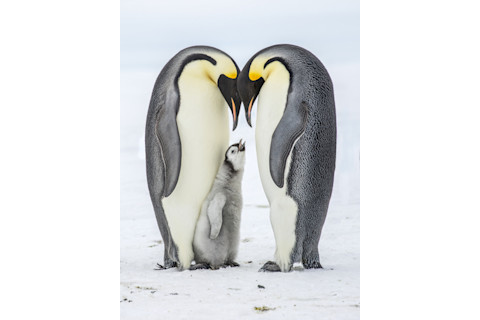
Credit: (Roger ARPS BPE1 CPAGB/ Shutterstock)
(Roger ARPS BPE1 CPAGB/ Shutterstock
Penguins are the best-dressed cold-weather animals in the Southern Hemisphere. Compared to other penguin species, the emperor penguin is the largest, standing about four feet tall and weighing up to 100 pounds. They have thick black and white feathers with orange and yellow plumage around their head, neck, and chest. An interesting fact about penguins: To stay warm on the harshest winter nights, emperor penguins huddle together in an ever-rotating circle to keep themselves and their chicks warm.
Where Do Penguins Live?
The majority of penguin species live in the Antarctic region, but they can also be found on the coasts of South America, Africa, Australia, and the sub-Antarctic islands.
What Do Penguins Eat?
Penguins mainly eat a variety of seafood. Their diet includes fish, squid, and krill. They are excellent swimmers and dive into the water to catch their prey.
How Long Do Penguins Live?
The lifespan of penguins varies by species. On average, they can live between 15 to 20 years in the wild, with some species living longer under ideal conditions. The IUCN categorizes the 18 species of penguins with conservation statuses ranging from "least concern" to "endangered."
Read More: How Do Penguin Wings Reach High Speeds Underwater?
4. Walrus
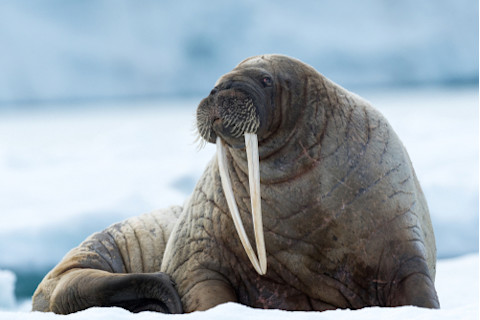
Credit: (Mats Brynolf/Shutterstock)
(Mats Brynolf/Shutterstock
The walrus is a unique-looking cold-weather animal. They can grow up to 11 feet long and weigh over 1 ton! You can often hear walrus bellowing at each other from a distance. They are a vital part of the marine ecosystem and are known for their adaptations to the Arctic environment. Their survival, however, is challenged by factors like climate change, which is affecting their sea ice habitat.
Where Do Walruses Live?
There are two subspecies of walrus – the Atlantic and the Pacific. The Atlantic lives off the coasts of Canada and Greenland while the Pacific lives off the coasts of Russia and Alaska.
What Do Walruses Eat?
Walruses primarily feed on invertebrates, especially mollusks like clams. They use their sensitive whiskers (vibrissae) to detect prey on the ocean floor. Walruses can also eat other organisms like shrimp, crabs, tube worms, soft corals, tunicates, and sea cucumbers. Occasionally, they might prey on fish.
Let's not forget their furry mustaches and long tusks! Their tusks are large canine teeth that continue to grow throughout their lives and are not used for eating. Walrus use their teeth for a variety of things, including dragging themselves out of the cold water and across the ice.
Why Are Walruses Declining?
Because of their blubber and tusks, they were often poached and hunted for fuel and trade. However, they are at risk from something else entirely now – climate change. Due to receding ice in the Arctic Circle, there is less space to hold the migrating walrus as they make their way to their food sources. Instead, they have been gathering on smaller, rocky islands that can’t possibly hold them all. Some have drowned while others have fallen from cliffs after trying to find a place to rest.
The clip below is from the Our Planet special on Netflix featuring David Attenborough. It’s very difficult to watch, so viewers' discretion is advised.
Read More: 5 of the Fiercest Animals in the Tundra
5. Snowy Owl
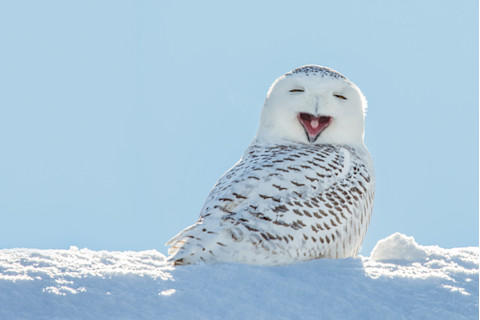
Credit: (James.Pintar/ Shutterstock)
(James.Pintar/ Shutterstock
Cue the Harry Potter theme music! Snowy owls have become one of the most popular owl breeds around the world. Renowned for its strikingly white plumage, which provides excellent camouflage in snowy environments, it has become a symbol of the Arctic's beauty and mystery.
Where Do Snowy Owls Live?
Snowy owls are typically found in North America, among the Arctic Circle and down into the northern United States. They can be found in Europe and Asia, as well.
It's possible to see snowy owls when they migrate to the northern U.S. for the winter. Keep an eye out for them during the day. They tend to perch on fence posts or tree branches. The owls’ white and black speckled feathers blend in with their surroundings, so watch for their striking yellow eyes.
What Do Snowy Owls Eat?
Snowy owls are incredibly smart and agile birds of prey. They primarily hunt small mammals like lemmings, voles, and mice, but they also prey on larger animals such as hares, rabbits, and even other birds, ranging from ducks and geese to songbirds and fellow raptors.
Snowy owls are also the heaviest owls in North America, weighing in at about four pounds due to their thick, insulating feathers. Unlike most owls, snowy owls are not nocturnal, mostly because of the long daylight hours of the Arctic Circle.
Read More: How Can Birds Of Prey Actually Lift and Carry Small Dogs?
6. Caribou
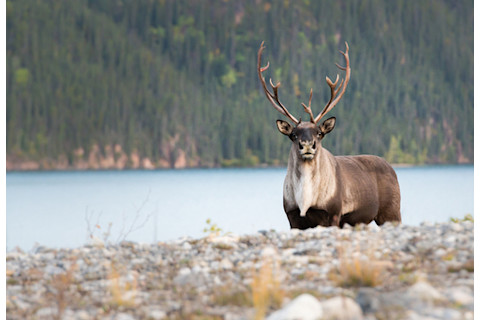
Credit:(Ghost Bear/Shutterstock)
Caribou is another popular cold-weather animal, especially around Christmas time. Caribou prefer the cold because they cannot stand the bugs that much on them in the summer. They've been known to run for several miles to shake off those pests.
Where Do Caribou Live?
They are found in North America, Europe, and Russia. In European countries, they have been domesticated.
Are Caribou and Reindeer the Same?
Yes, caribou and reindeer refer to the same species (Rangifer tarandus). The term "reindeer" is commonly used in Europe and Asia, particularly for domesticated or semi-domesticated animals, while "caribou" is used in North America to refer to wild populations.
A unique aspect of the caribou is that they are one of the few species of deer where both males and females grow antlers.
What Do Caribou Eat?
Caribou are primarily herbivores. Their diet consists of a variety of plants, including grasses, sedges, mosses, lichens (notably reindeer moss), leaves, and twigs.
Caribou have hollow-bottomed hooves that make it easier to dig up food that is under the snow. Their short bodies and thick fur help keep them warm while their long legs help them move through the snow. You can visit a herd of friendly caribou in Scotland in the Cairngorm mountains.
7. Beluga Whale
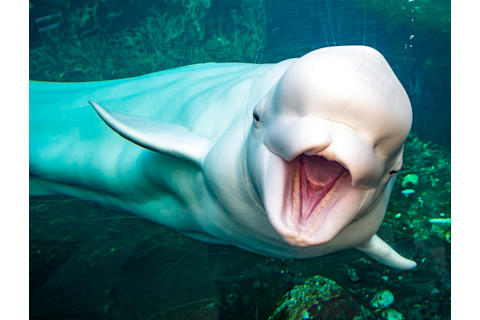
Credit: (CJ Larsen/Shutterstock)
(CJ Larsen/Shutterstock
Beluga whales are another unique cold-weather animal and are found predominantly in Arctic and sub-Arctic regions. They inhabit cold coastal waters around North America, Russia, and Greenland. Beluga whales are commonly seen in the waters of the Arctic Ocean, particularly in areas like the Bering Sea, the Canadian Arctic Archipelago, and around Greenland.
They are also known to travel into estuaries and river basins. Early sailors noted how much these whales squeaked and chirped, nicknaming them "the canaries of the sea."
What Do Beluga Whales Eat?
Beluga whales are social animals that hunt and migrate in pods. They have a diverse diet, primarily feeding on fish, crustaceans, and cephalopods. This includes species like salmon, herring, cod, shrimp, squid, and octopus. Their feeding habits can vary depending on their location and the season.
Are Beluga Whales Endangered?
Beluga whales are an important part of the ecosystem; however, due to oil drilling and ocean noise their habitat and health is at risk. They are classified as near threatened on the IUCN Red List.
Read More: Understanding How Whales Communicate
8. Arctic Fox
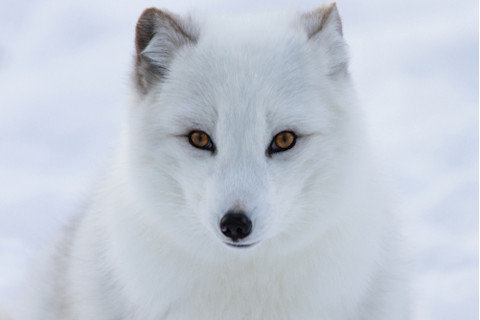
Credit:(Pierre Cornay Photography/Shutterstock)
The Arctic fox has learned to adapt and survive the tundra in impressive ways. Their fur is pure white during the winter but changes to brown/gray during the warmer months to help it stay camouflaged.
How Do Arctic Foxes Survive?
The Arctic fox has shorter ears and snout compared to other fox breeds. Shorter extremities are easier to keep warm. The Arctic fox can survive temperatures as low as negative 58 degrees Fahrenheit! Its furry toes and fluffy tails also aid in keeping the Arctic fox warm.
What Do Arctic Foxes Eat?
The Arctic fox hunts for small mammals and is known to even follow polar bears around to eat their leftovers. When food is scarce, they will eat vegetation, as well.
Read More: Arctic Fox and Other Polar Predators May Have Originated In the Himalayas
9. Harp Seal

Credit:(COULANGES/Shutterstock)
Yet another adorable cold-weather animal, harp seals have thick, oily fur and lots of blubber to help them stay warm in the frigid waters of the Arctic. Baby harp seals keep their fluffy white coat until they are about two weeks old. By then, their dark fur begins to grow in.
Where Do Harp Seals Live?
These seals live off the coasts of Canada, Greenland, Norway, and Russia.
What Do Harp Seals Eat?
Harp seals primarily feed on a variety of fish and invertebrates. Their diet includes capelin, herring, cod, and polar cod, as well as krill and other small crustaceans. They are adapted to hunt in the icy waters of their habitat, using their sensitive whiskers to detect prey.
Are Harp Seals Endangered?
Harp seals are not currently classified as endangered. They are listed as least concern by the IUCN. Seals are still hunted for their fur, but in recent years seal hunting has become a much more controversial topic.
Read More: Seals Caught On Film Clapping In the Wild For the First Time Ever
10. Arctic Hare
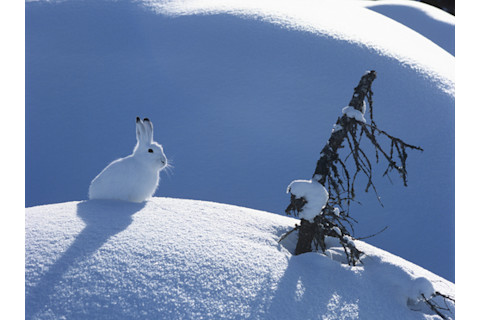
Credit: (sirtravelalot/Shutterstock)
(sirtravelalot/Shutterstock
The Arctic hare is without a doubt one of the most adorable cold-weather animals around. Unlike other rabbit breeds, Arctic hares do not hibernate during the winter. Instead, they have adapted to the tundra with their thick fur and shortened ears. During the winter, their fur remains a brilliant white to match the snow. However, during the spring it changes to a grayish blue to blend in with the rocks and other surrounding vegetation.
Where Do Arctic Hares Live?
They are primarily found in the Arctic regions of North America and Greenland. Their habitat includes the open tundra and rocky mountainous areas.
What Does an Arctic Hare Eat?
Arctic hares feed on roots, berries, mosses, and other vegetation, and were once a vital source of food and clothing for Native American tribes. Since Arctic hares are prey animals, they have adapted speed and agility through the ice and snow, often reaching speeds of 40 miles per hour!
Read More: 4 Hidden Ways Animals Camouflage Themselves
This article was originally published on Dec. 9, 2021 and has since been updated by the Discover staff.



